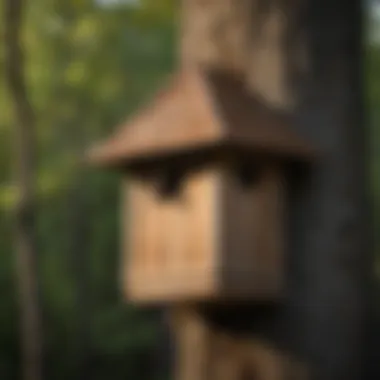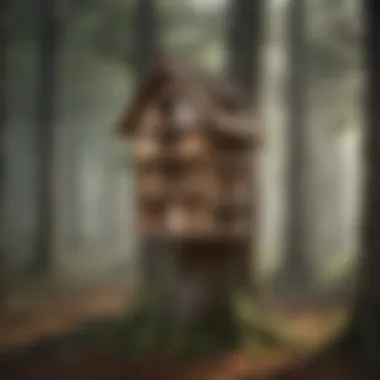Optimal Placement of Bat Houses: A Comprehensive Guide


Intro
Placing bat houses properly is critical for attracting bats, which play essential roles in ecosystems. Understanding the nuances of their habitat preferences can greatly influence the success of bat house installation. This guide will explore the relevant factors for optimal bat house placement, covering environmental aspects, ideal locations, and construction tips. With this knowledge, readers can contribute positively to bat conservation efforts.
Overview of Bat House Placement
Effective bat house placement is an art and science. It involves knowing about the bats' natural behavior and their habitat needs. Bats seek shelter that provides safe roosting sites. Thus, a thoughtful approach is necessary in choosing where to put bat houses.
- Consider temperature: Bats prefer warm environments. Placing the house in direct sunlight for a portion of the day can warm the structure.
- Elevation matters: Ideally, bat houses should be mounted 12 to 20 feet off the ground to discourage predators.
- Access to food: Ensure there is a nearby source of insects, as bats actively hunt for food at dusk.
Environmental Factors
When considering the optimal placement of bat houses, it is crucial to analyze various environmental conditions that will influence the outcome.
- Sunlight exposure: Bat houses should receive a good amount of sunlight. Morning sun helps maintain interior warmth, encouraging bats to roost.
- Wind protection: Position bat houses away from strong winds and rain. Use natural barriers like trees or buildings for shielding.
- Avoid disturbance: Choose locations that minimize human interference, as too much activity can deter bats from taking residence.
Ideal Locations
Choosing the right location for a bat house is essential for attracting bats successfully. Here are some ideal sites and considerations:
- Near water sources: Bats are often found near rivers, ponds, or other water bodies. Proximity to these areas improves chances for habitation.
- Open areas: Avoid dense brush or heavy foliage as bats like open spaces for easy take-off and landing.
- Distance from light: Excessive artificial light can disrupt bats' natural behaviors, making darker locations more appealing.
Construction Tips
Building a reliable bat house is vital. While many plans are available, certain construction features may enhance its effectiveness:
- Materials: Use untreated wood for the bat house to avoid harmful chemicals. Cedar or plywood works well.
- Design: Ensure the house has a design that allows for easy access. Ventilation holes and a rough interior can help facilitate bat roosting.
- Maintenance: Regular checks and maintenance will keep the bat house functional and free of pests.
"Proper placement and construction of bat houses can significantly influence the success of attracting bats. Understanding their preferences is the key to effective conservation practices."
Summary
In summary, optimal placement of bat houses demands a keen understanding of environmental factors, ideal locations, and sound construction practices. By following the principles and recommendations outlined in this guide, there is potential to enhance bat conservation efforts and foster healthy ecosystems.
Today, as their habitats dwindle, every small effort to create safe havens for bats counts. Through informed placement and construction, we can ensure that these valuable creatures thrive in our environments.
Prologue to Bat Houses
Bat houses serve as essential structures designed to provide shelter for bats, which play a crucial role in maintaining ecological balance. The placement of these houses is not only beneficial for the bats but also advantageous to people as bats contribute to pest control by consuming large quantities of insects. This section discusses the effective strategies for placing bat houses and why such considerations matter.
Understanding how to properly install bat houses can lead to higher rates of occupancy and subsequently healthier bat populations. Choosing the right location is critical. Various environmental factors influence bat behavior and comfort, which in turn affects their willingness to roost. This guide aims to illuminate these factors and advocate for effective practices in bat house placement.
Understanding Bats and Their Habitats
Bats are unique, warm-blooded mammals belonging to the order Chiroptera, recognized for their ability to achieve flight. They inhabit diverse environments, ranging from forests to urban areas. Each species has specific habitat requirements, such as temperature, humidity, and shelter needs. The majority of bat species are insectivorous, relying on a substantial insect intake to survive. Therefore, habitat management that encourages healthy insect populations is paramount.
Their natural habitats often include tree cavities, rock crevices, and abandoned buildings. However, urbanization and habitat destruction have significantly reduced these natural roosts, making human intervention vital. By placing bat houses in suitable locations, individuals and communities can provide necessary shelter while fostering biodiversity in their local environment.
Importance of Bat Conservation
Bat conservation is of paramount importance due to their ecological significance and the pressing threats they face. Bats contribute significantly to ecosystem services, predominantly through pest control and pollination. A single bat can consume thousands of insects in a single night, thus providing a natural solution to pest management.


Additionally, many bat species are currently facing dramatic population declines due to habitat loss, climate change, disease, and pesticide use. Raising awareness about their ecological role is essential, as is encouraging the installation of bat houses to create safe environments for roosting. Promoting conservation efforts can yield positive effects not just for bats but for overall ecosystem health.
"Conservation is a state of harmony between men and land." - Aldo Leopold
By understanding the importance of bats and their habitats, we can become better stewards of our environment. The following sections will delve deeper into the specific factors affecting bat house placement.
Key Factors Influencing Placement
Placement of bat houses plays a crucial role in attracting bats. Understanding the key factors can enhance the success rate of establishing a colony. Each element affects bat behavior and willingness to roost. Therefore, addressing these factors ensures better outcomes for bat conservation efforts.
Sunlight Exposure
Sunlight exposure is significant for bat houses. Bats prefer warm environments as it helps with thermoregulation. Homes should be positioned where they receive adequate sunlight for part of the day, typically around six to eight hours. This warmth attracts bats, making the house more inviting.
Placing houses on the south or southeast side of structures can optimize sunlight capture. This positioning aids in warming the interior for the bats while preventing the roost from becoming too hot in summer months. However, excessive direct sunlight can lead to overheating, which should be avoided. Hence, partial shade is also beneficial, especially during peak summer.
Height and Accessibility
Height matters substantially in bat house placement. Most bats choose to roost at higher elevations, often between 12 to 20 feet off the ground. This elevation protects them from potential land-based predators. Additionally, placing bat houses high up enhances visibility for bats as they can spot approaching threats.
Accessibility is another consideration. Though houses must be high, they should be reachable for maintenance purposes. Using a pole or mounting on a sturdy tree promotes safety during installation and subsequent checks. An appropriate design ensures the safety of both bats and the maintainers.
Proximity to Water Sources
Bats need water, primarily for hydration. Placing bat houses within a reasonable distance of natural water sources is beneficial. Lakes, ponds, and streams attract insects, which in turn attract bats. Usually, houses should be located no more than a quarter mile from water sources. This distance ensures a steady food supply for the bats.
Additionally, consider the surrounding vegetation. Natural plant growth around water bodies can provide shelter and foraging opportunities, enhancing the habitat’s attractiveness. Plants like cattails or willows encourage insects, providing further food resources for the bats.
In summary, the selection of bat house location cannot be arbitrary. Attention to sunlight exposure, height, accessibility, and proximity to water creates a welcoming habitat conducive to maintaining a healthy bat population.
Ideal Locations for Bat Houses
Selecting the right location for bat houses is crucial for attracting these nocturnal mammals. Bats provide numerous ecological benefits such as pest control and pollination, making their conservation important. The ideal placement enhances the chances of occupancy and offers a harmonious balance between the bats’ needs and environmental factors. Various settings present unique attributes and considerations, which can influence the success of bat houses.
Rural vs. Urban Settings
Rural areas often provide the most conducive environment for bat houses. Wide open spaces in countryside regions ensure an abundance of natural resources. Greater insect populations in these regions offer ample foraging opportunities for bats. Additionally, rural settings generally have fewer human disturbances, ideal for roosting.
In contrast, urban environments pose challenges. Despite this, bats can thrive in cities. Many urban areas have parks and green spaces that serve as habitats. The presence of built structures can create roosting options. However, it is imperative to understand local regulations and human interactions when placing bat houses in urban settings.
Tree Locations
Trees serve as natural roosting sites for bats. When planning bat house placement, consider positioning them near large trees. Trees, especially those with dense foliage, offer shade and nesting opportunities. Bats prefer elevated spots that mimic their natural habitats. Ideally, the bat house should be 10 to 20 feet high, easily accessible to bats but out of reach of potential predators.
Moreover, trees near water bodies can enhance insect populations, providing bountiful feeding opportunities. The presence of nearby water can also offer bats a drinking source, which is critical, especially in warmer seasons.
Building Facades and Overhangs
Using the walls of buildings can be an effective strategy for bat house placement. Bat houses can be mounted on the facades of buildings, especially those that receive adequate sunlight. Overhangs can provide shelter from rain and wind. Bats benefit from the warmth generated by building materials.
When installing on buildings, ensure that placement is high enough to avoid disturbances. It is advisable to mount bat houses in more secluded areas of the building. This encourages occupancy by reducing human interactions. To enhance the suitability of these locations, bat houses can be painted in darker shades to absorb more heat.


"The placement of bat houses directly influences occupancy rates, making it critical to choose locations carefully."
In summary, each type of location presents distinct advantages for bat house placement. Understanding the differences between rural and urban settings, the suitability of trees, and the advantages of building facades allows for informed decisions. This careful consideration not only attracts bats but also fosters a greater appreciation for their ecological roles.
Construction Considerations for Bat Houses
The effectiveness of bat houses largely depends on their design and construction. Properly constructed bat houses can provide safe and suitable shelters for bats. This section delves into the key materials and design features that will help attract bats and ensure the longevity of the bat house.
Materials Best Suited for Bat Houses
Choosing the right materials for bat houses is essential for their functionality and durability. Here are some materials that work best:
- Wood: Untreated wood is a common choice for bat houses. Cedar and pine are preferred because they have natural resistance to decay. It is crucial to avoid painted or treated wood. The chemicals in paint and treatment can be toxic to bats.
- Plywood: Marine-grade plywood can also be suitable, but it should be untreated. It provides strength against weather elements while being lightweight.
- Exterior-grade nails or screws: Use strong, rust-resistant materials to build the structure.
- Insulation materials: While not always necessary, some builders add insulation in larger bat houses to maintain temperature. However, care must be taken to ensure the insulation is safe for bats.
The choice of material should also consider the climate. In warmer areas, choose materials that will keep the house cool, while in colder climates, thicker materials might be favored to provide insulation.
Design Features that Attract Bats
The design of a bat house plays a major role in attracting bats. Here are some critical design elements to consider:
- Size: A bat house should ideally be at least 24 inches tall and 14 inches wide. This allows space for multiple bats to occupy at once. The dimensions help provide adequate nesting space.
- Roosting chambers: The interior should have multiple chambers, ideally separated by dividers. This provides privacy and a comfortable space for bats.
- Rough surfaces: Bat houses should have rough interior walls to help bats cling as they roost. This can be achieved by leaving the wood unplaned or adding strips of wood.
- Ventilation: Good airflow is crucial to prevent the buildup of heat. Small holes near the top of the house can help with this.
- Placement of entrance: The entrance should be positioned at least 20 inches off the ground to protect bats from predators. If multiple entrances are included, they should be staggered.
By paying careful attention to the materials and design features, crafters can create an inviting environment for bats. Such considerations not only foster bat habitation but also contribute to bat conservation efforts. As we continue to build structures modelled for these important creatures, the benefits of biodiversity and ecological balance become evident.
Timing for Installation
The timing of installing bat houses is a critical aspect that influences their success in attracting bats. The nuances of seasonal changes and bat behavior play significant roles in determining when to effectively place these houses. Understanding this timing can enhance the likelihood of bat occupancy and provide these essential creatures with safe habitats.
Optimal Season for Bat House Placement
The ideal timeframe for placing bat houses typically falls during late winter or early spring. This timing is important because bats emerge from hibernation during this period. By installing bat houses before this emergence, you provide them with a ready-made habitat that they can occupy as they begin to become active again. An early installation can lead to higher occupancy rates.
Considerations for Timing:
- Weather Conditions: Placing bat houses when the weather is stable and mild can encourage bats to explore new homes.
- Avoid Late Spring/Early Summer: The placement in these months may not be ideal as bats will have already established roosts, thus making it less likely they'll explore other options.
"Timing is not just a matter of convenience, but a core element in fostering bat habitation. The early bird may indeed catch the bat!"
In addition, if you live in areas where winter is harsh, consider ensuring that your bat house is insulated or sheltered from extreme elements when placed.
Avoiding Disturbances During Maternity Season
Maternity season is a crucial time for bat populations, as this is when female bats give birth and nurture their young. Generally, this period occurs from late spring to early summer. Disturbing bats during this time can have serious consequences, leading to site abandonment or reduced survival rates for the young bats.
To avoid disturbances:
- Installation Before Maternity Season: Make sure that your bat house is in place well before the maternity season begins. This ensures that bats can establish themselves early, minimizing the disturbance risk later on.
- Monitor Activity Levels: Those who already have bat houses should monitor bat activity prior to this crucial time. If there is significant activity in late spring, it might be wise to delay any changes to existing houses.
Closure on Timing
Overall, understanding the timing for installation can greatly influence the effectiveness of bat houses. By strategically placing them well before maternity season and during optimal weather conditions, you enhance the chances that bats will occupy the structures, ultimately fostering bat conservation and ecological benefits.


Monitoring and Maintenance
Monitoring and maintenance of bat houses is essential for ensuring the success of your bat conservation efforts. Regular checks help you assess whether bats are actually occupying the houses you have provided. This not only encourages their well-being but also allows you to make adjustments as necessary. Understanding the signs of occupancy can inform you about the habitat's health, while proper maintenance practices can prolong the lifespan of the bat houses and create a sustainable environment.
Signs of Bat Occupancy
Identifying signs of bat occupancy is the first step in evaluating whether your bat house is functioning effectively. These signs can vary by species, but there are several common indicators to look for:
- Guano: Bat droppings are often the most prominent sign. If you notice small pellets beneath the bat house, it usually indicates roosting activity.
- Echoes: Listen for sounds. Bats may emit high-pitched calls or chirps when they are active, mostly at dusk.
- Flight Patterns: Observe the area at twilight. If bats frequently fly in and out of the house, it suggests a thriving colony.
- Nest Material: Occasionally, you might find bits of vegetation or other materials that bats might use for nesting, which can be a positive sign of occupancy.
Recognizing these signs combines visual inspections with auditory observations, creating a clearer picture of the bat population in your area.
Regular Maintenance Practices
To ensure the ongoing suitability of bat houses, regular maintenance is critically important. Neglecting this can lead to structural issues or a decline in bat occupancy. Here are some practices to adopt:
- Annual Inspections: Checking for damage to the structure is vital. Cracks, broken hinges, or loose panels can deter bats. Fix any damage promptly.
- Cleaning: As a general rule, bat houses should not be cleaned completely, as the old guano can provide scent trails for new bats. However, it’s sensitive to remove excessive droppings and debris that may introduce disease or attract pests.
- Check for Pests: Monitor for insects or predators that could endanger the bats. Pest control should be handled carefully to avoid harming the bats.
- Winter Preparation: In colder climates, ensure the house is insulated and secure before winter takes hold. Bats can use bat houses for hibernation.
Regular commitment to monitoring and maintenance can significantly enhance your efforts in bat conservation, resulting in a more successful habitat for these important creatures.
"Understanding maintenance is as crucial as the initial placement of the bat house. It ensures that our interventions remain effective and sustainable over time."
By actively monitoring signs of occupancy and practicing thorough maintenance, we create environments that bats can thrive in for years to come.
Common Challenges and Solutions
Placement of bat houses often comes with distinct challenges. Understanding these hurdles is crucial for those looking to create suitable habitats for bats. Addressing these challenges effectively can lead to successful bat occupancy, enhancing local ecosystems.
Predator Encounters
Predators can pose a significant threat to bat populations. Birds of prey, snakes, and raccoons are known to target bats when they are at their roosts. To mitigate this, one must first choose the right location for the bat house.
- Height: Installing bat houses at least 10-15 feet above the ground makes it more difficult for ground predators to access them.
- Enclosure Design: Bat houses should also have narrow entrances and exits to avoid larger predators. This simple design feature can significantly reduce rates of predation.
- Surrounding Environment: Clearing potential perches near the bat house can minimize chances for predators to scout the area.
Additional considerations include recognizing the local ecology. For example, if hawks or owls are common in the area, placing houses in more sheltered spots may help protect bats. By focusing on these strategies, one can create a safer environment for bats, thereby increasing their occupancy rates.
Environmental Hazards
Environmental hazards can affect the safety and health of bat populations. Various factors including severe weather, pollutants, and habitat destruction play a role.
- Weather Exposure: Bat houses should be installed in areas that are not severely exposed to high winds or direct, intense sunlight for prolonged periods. Humidity and temperature fluctuations can also impact bats negatively. A proper orientation relative to the prevailing winds will reduce exposure.
- Pollution: Chemicals used in nearby agricultural practices can pose threats to bats. It is important to understand the land use around the bat house. Avoid placing bat houses near source of harmful pollutants. Maintaining distance from industrial areas can greatly decrease risk from exposure.
- Habitat Connectivity: Fragmentation of habitats may hamper bats’ accessibility to vital resources such as food and shelter. Placing bat houses near connecting corridors like tree lines or rivers can help alleviate this issue. Bats are more likely to thrive in landscapes that offer a diverse range of habitats.
In summary, recognizing these common challenges and applying effective solutions is critical for bat house placement success. Through strategic design choices and environmental considerations, it is possible to create a thriving habitat for these invaluable creatures.
Finale: Enhancing Bat Habitats
The optimal placement of bat houses is crucial in supporting bat populations and promoting their conservation efforts. This article examined various factors that affect the successful installation and operation of bat houses. The principal focus is to create habitats that are not only welcoming but also protective against various challenges such as environmental hazards and predation.
In engaging with the topic of enhancing bat habitats, it is important to consider multiple elements, including the selection of ideal locations, construction materials, and the timing of installation. Each aspect contributes significantly to attracting bats and ensuring their sustainability within those habitats.
Key benefits of well-placed bat houses include:
- Natural Pest Control: Bats consume large amounts of insects, which can help in reducing pest populations, thus benefiting nearby agricultural practices or residential areas.
- Biodiversity Support: By providing a habitat for bats, communities contribute to maintaining ecological balance and promoting biodiversity in local ecosystems.
- Educational Opportunities: The presence of bat houses can foster community interest in conservation and wildlife, leading to increased awareness about the ecological roles of bats.
The considerations associated with bat house placement extend beyond mere aesthetics. Not only do these efforts reflect a commitment to wildlife conservation, but they also enhance the overall health of surrounding environments. Monitoring and maintaining the bat houses after installation is equally important to ensure that these creatures thrive and continue to serve their valuable ecological role.
"Understanding the habitat needs of bats is essential for their survival. Proper placement of bat houses truly enhances both their lives and the ecosystem."
In summary, enhancing bat habitats involves an intricate interplay of environmental factors, location strategies, and thoughtful design choices. By following the guidelines set forth in this article, individuals and communities can engage effectively in bat conservation efforts, thereby fostering a greater appreciation for these remarkable creatures.















